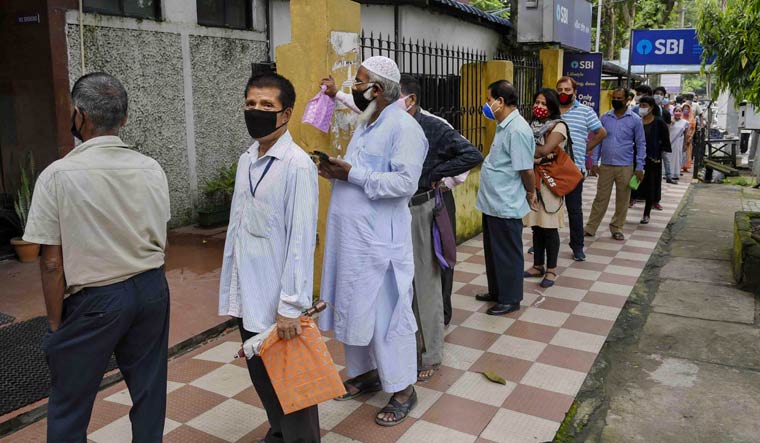In the beginning of the year, the Indian economy was undergoing its slowest growth period in recent times. Now faced with the unforeseen effects of the COVID-19 pandemic, the growth story is at the mercy of an unprecedented economic downturn. The International Monetary Fund (IMF) has observed that the COVID-19 pandemic will lead to a global recession in 2020-2021 that will be at least as severe as the downturn during the economic and financial crisis of 2008.
The financial sector, unsurprisingly, has borne the brunt of the cascading effects of the pandemic as the various stakeholders—banks, businesses and customers—look for new forms of engagement. Despite the uncertainties and headwinds, the financial sector is well positioned to turn this crisis into an opportunity. After the 23.9 per cent GDP contraction between April-June, economic activities are slowly getting back on its feet. For the banking sector, the goal would be to expedite growth through various instruments and assure all concerned stakeholders of the easy availability of credit in what is an unprecedented moment in history.
Moratorium, financial stimulus, intended effect and measures by the RBI
The report by the Reserve Bank of India’s (RBI) expert committee on a resolution framework, headed by former ICICI Bank chief K.V. Kamath, notes that the pandemic “has affected the best of companies” and businesses that were otherwise viable before the outbreak. Consequently, the RBI has increased the limit under ways and means advances (WMAs) for the central and state governments. In Targeted Long Term Repo Rate Operations (TLTROs 2.0), as announced on April 17, an aggregate amount of Rs 50,000 crore was particularly aimed at supporting NBFCs.
The regulatory initiatives of the RBI include permitting commercial banks and financial institutions to provide a moratorium of three months on payment of instalments in respect of all term loans outstanding as on March 1 and deferment of interest on working capital facilities for three months on all such facilities. These were further extended for another three months till August 31. Following this, there has been a huge demand on banks to waive interest for this moratorium period. From the banking sector’s point of view, offsetting interest from the moratorium period would mean taking a toll on profitability while Net Interest Margin (NIM) would be seriously affected.
A longer moratorium period exceeding six months can impact credit behaviour of borrowers and increase the risks of delinquencies post resumption of scheduled payments. However, banks might have to play a balancing act as the absence of financial incentives could dent prospects of, for instance, the informal sector that has been one of the worst affected. This sector is in dire need of capital whereas their creditworthiness is at an all-time low. To arrest this downfall, the RBI mooted a special resolution window for COVID-19 related stress that strikes a balance between maintenance of financial stability and preservation of the economic value of viable businesses through provision of suitable relief. This offers a more tailored approach to the specific needs of individuals rather than a broad-brush approach.
Consumer perspective and need for greater dialogue and understanding on both sides
The gross non-performing asset (NPA) ratio of all commercial banks is likely to increase from 8.5 per cent in March 2020 to 12.5 per cent by March 2021 under the baseline scenario in the wake of the disruption caused by the Covid-19 pandemic, the Reserve Bank of India (RBI) said. According to the RBI, nearly 50 per cent of the customers, accounting for around half of outstanding bank loans, opted to avail the benefit of the relief measures—loan moratorium—to tackle the lockdown impact. While the RBI had infused liquidity of about 3.2 per cent of GDP into the system early on in the lockdown period, it is now up to the banks to pass on the liquidity to NBFCs and industry.
However, the rising level of bad debts is creating a sense of caution among banks towards lending to cash-strapped firms. Therefore, the more prudent approach would be to go for smaller scale lending at competitive interest rate levels that will not just allow businesses and individuals to cover operating costs, but also steady the financial tightrope of banks, vis-à-vis, its depositors. In a much-needed move that would benefit the vulnerable category of borrowers, the government has supported waiving compound interest or ‘interest on interest’ for loans upto Rs 2 crore. The government has also assured lenders that the financial burden of the waiver will not have to be borne by them. According to Devendra Pant, chief economist at India Ratings & Research, ‘the waiver would provide both relief to borrowers and protect the bank’ balance-sheet from any impact due to small borrowings.’
Nonetheless, in the current environment, the need for financial intermediaries to proactively augment capital and improve their resilience has acquired top priority. “In the evolving milieu, while risk management has to be prudent, extreme risk aversion would have adverse outcomes for all,” Das said. The banks could take a leap of faith with those borrowers (small businesses and individuals) who have had more-than-satisfactory creditworthiness pre-COVID-19 and boost prospects of the financial system.
Long-term effects of loan non-repayments and piling NPAs
Cash flow of companies is squeezed and creditworthiness of borrowers is uncertain. There is no question that the impact on the banking sector and resultant NPAs will be massive. In a scenario where credit financing and repayment are weak, banks would need to provision for unforeseen NPAs in the near term. While public sector banks will not have adequate capital, thereby needing the RBI to infuse capital, private banks facing negative rating require bail-outs like in the case of Yes Bank and PMC recently. Despite the acute crisis faced by the sector, banks have realized the level of support that it needs to extend to badly-hit businesses. Therefore, banks have sought a more durable plan wherein the focus would be to rebalance the debt burden of viable borrowers relative to their cash flow generation abilities.
In essence, the financial sector should be the linchpin of economic recovery. At a time when small businesses and borrowers have struggled to make ends meet, the banks and financial institutions must respond to some of the immediate imperatives to facilitate business continuity. Short-term recovery of this category of borrowers is key and therefore, banks could tailor their lending strategies on a case-to-case basis. On the NPA issue, it is perhaps inevitable that banks might have to swallow some bad loans and consequently, restructure its books to prevent a collapse. Towards this end, the government and RBI must continue to relax asset classification norms for banks and provide monetary stimulus to protect businesses from going bust.
Siddharth Shirole is an elected member of the Legislative Assembly of Maharashtra. Sahil Deo is the co-founder of CPC Analytics, a data-driven policy consulting firm with offices in Pune and Berlin.
The opinions expressed in this article are those of the author and do not purport to reflect the opinions or views of THE WEEK






